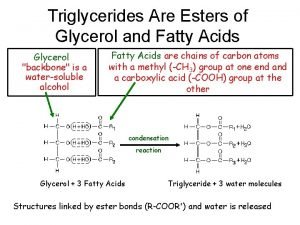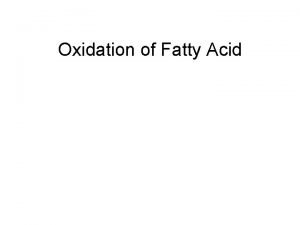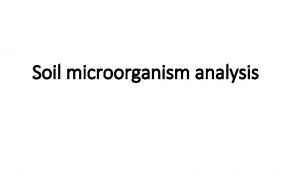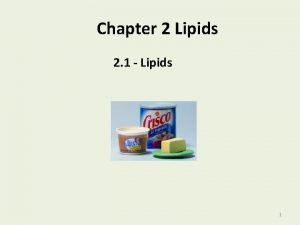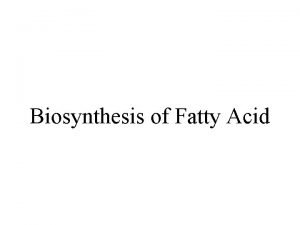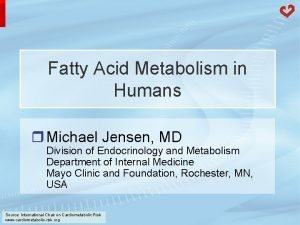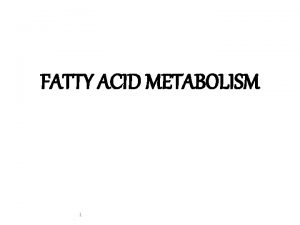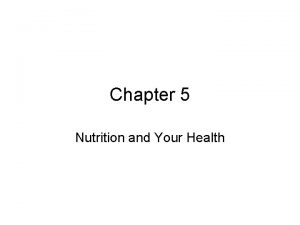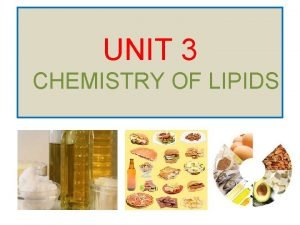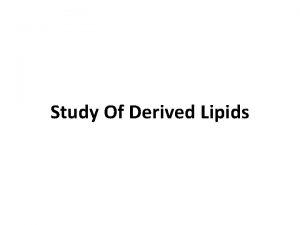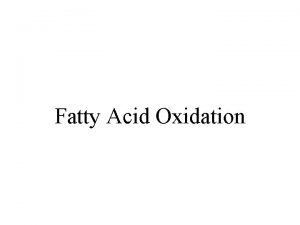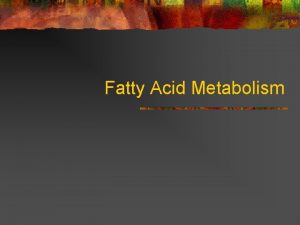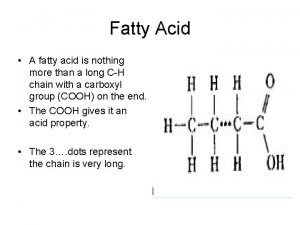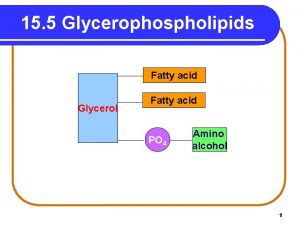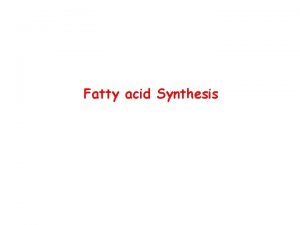Lipids and Lipids Oh My Fatty acid Palmitic











- Slides: 11

Lipids and Lipids – Oh My! Fatty acid Palmitic acid Triacylglycerol Triglyceride Saturated fatty acid Unsaturated fatty acid Monounsaturated fatty acid “Trans fatty acid” Polyunsaturated fatty acid Stearic acid Oleic acid Oil Phospholipid Cholesterol Steroids Testosterone Estrogen Waxes Lard Omega-3 -fatty acids Free fatty acids “Butter” “Margarine” Olive oil Flax seed oil “Toasted Sesame oil” Bile salts “Vegetable shortening” “Hydrogenated vegetable shortening” “Partially hydrogenated oil”

Lipids Relatively insoluble in water (hydrophobic) • Consist mostly of carbon & hydrogen (hydrocarbons) • • very few oxygen molecules (thus hydrophobic) Greasy/oily consistency • Some solid at room temp, others liquid at room temp • Nutritionally significant forms: • 1. Triglycerides (Fats & Oils) 2. Phospholipids 3. Sterols 4. Carotenoids

1) Triglycerides • • A. k. a. Are the most abundant lipids (95%) in living organisms Consist of a glycerol backbone + 3 fatty acids (FA) Efficient storage form of fuel • Yields twice as many Calories (9 Calories/gm) as carbs Excess Carbs and excess proteins are converted into fat and stored as fat Functions: • • • Cushion / pad Retain heat Make up 50% of cell mem. Make up certain hormones Store vitamins A, D, E, K Provide satiety

FAs may be saturated or unsaturated Solid at room temp Polyunsaturated FA Liquid at room temp

Lipids contain 2 X Calories of Carbs and 9 kilocalories/gm Proteins.

extra Calories add up…

Most lipids are a mixture of saturated, monounsaturated, and polyunsaturated FAs

Making a good thing bad… Hydrogenation Lipids w unsaturated FAs typically cheaper shorter shelf life due to oxidation at points of unsaturation Tend to be too oily for some recipes E. g. cookies, muffins, breads… The Solution: add Hydrogen (by hydrogenation) and “saturate” the unsaturated FAs Longer shelf life. Slower to turn rancid. Thicker, more spreadable. Higher “smoking point. ” Less likely to burn. Sometimes creates trans-fatty acids Classic e. g. = margarine

2) Phospholipids • Consist of glycerol & 2 fatty acids and a phosphate group • “heads” and “tails” 1 o function is to serve as a cell membrane component • Also plays role in emulsification of lipids for digestion • • • E. g. Lecithin in bile E. g. transport of lipids in blood

3) Sterols) Consist of rings of carbon atoms Examples: Cholesterol • stabilizer of cell membranes • emulsifier in bile Some hormones Testosterone, Estrogen, Progesterone, & Cortisol

4) Carotenoids • • • Plant pigments: usually Orange and yellow E. g. beta-carotene, lycopene, lutein, many others Often act as anti-oxidants • • May help prevent cell damage leading to cancers Some are the basis of Vit. A used to produce visual pigment retinal for both day and night vision
 Glycerol and palmitic acid reaction
Glycerol and palmitic acid reaction Beta oxidation of myristic acid
Beta oxidation of myristic acid Phospholipid fatty acid analysis soil
Phospholipid fatty acid analysis soil Acetylco a
Acetylco a Iupac name of fatty acid
Iupac name of fatty acid Steroid nucleus
Steroid nucleus Fatty acid synthesis
Fatty acid synthesis Free fatty acids vs triglycerides
Free fatty acids vs triglycerides Fatty acid synthesis steps
Fatty acid synthesis steps Chapter 5 nutrition and your health
Chapter 5 nutrition and your health Chemical properties of fatty acid
Chemical properties of fatty acid Unsaturated fat chain
Unsaturated fat chain
